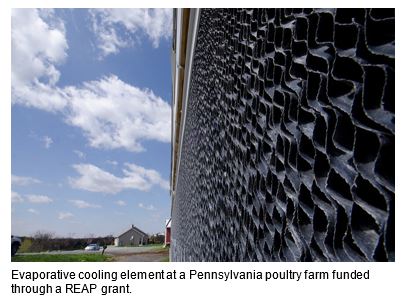The latest numbers from USDA Rural Development show the Rural Energy for America Program, which was originally created in the 2002 farm bill, has awarded nearly $3 billion in grants and loan guarantees since it was reauthorized and given substantial funding in the 2008 farm bill. (Click here for a complete rundown of how REAP funds are spent.)
 Funding available under the program includes grants for up to 25 percent of total eligible project costs; combined grant and loan guarantee funding up to 75 percent of total eligible project costs; and loan guarantees on loans up to 75 percent of total eligible project costs.
Funding available under the program includes grants for up to 25 percent of total eligible project costs; combined grant and loan guarantee funding up to 75 percent of total eligible project costs; and loan guarantees on loans up to 75 percent of total eligible project costs.
Terms for renewable energy system grants are $2,500 minimum and $500,000 maximum, while the terms for energy efficiency grants are $1,500 minimum and $250,000 maximum.
From 2009 through 2016, 11,156 REAP grants totaling more than $357 million were awarded, while USDA used the program to guarantee 997 loans totaling $626.7 million over that same period.
Some 60 percent of the projects funded (6,453) were energy efficiency projects. Over the eight years, they received $149.7 million in REAP grants, while the program guaranteed $52.8 million in loans. Eligible energy efficiency improvements include high efficiency heating, ventilation and air conditioning systems (HVAC); insulation; lighting; cooling or refrigeration units; doors and windows; electric, solar or gravity pumps for sprinkler pivots; switching from a diesel to electric irrigation motor; and the replacement of energy-inefficient equipment.
USDA says 4,289 renewable energy projects were awarded $193.4 million in grants or had loans totaling $572.9 million guaranteed. The money can be used to purchase, install and build renewable energy systems, such as biomass (for example: biodiesel and ethanol, anaerobic digesters, and solid fuels); geothermal for electric generation or direct use; hydropower below 30 megawatts; hydrogen; small and large wind generation; small and large solar generation; and ocean (tidal, current, thermal) generation.
Agricultural producers have had the greatest number of applicants receiving REAP money, some 7,150, compared to 3,870 small rural businesses. But producers held only a slight edge in grants received – $182 million – laid against the $175.2 million to small businesses. The latter group held a whopping 9-1 advantage in loan guarantees, with REAP making $562.9 million available to cover their loans compared to the $62.9 million put up for ag producers. And small businesses also had a huge lead in total project costs, nearly $3 billion compared to the $761.4 million in total costs estimated for ag producer projects.
Iowa, with its national leadership in wind energy capacity and production, has received by far the most in grant money among states, nearly $48 million, with Minnesota following at $19.75 million. Other states recording big REAP grant totals over the 8-year period were Ohio ($15.9 million), Illinois ($14.2 million), Georgia ($13 million), North Carolina ($12.9 million), Indiana ($12.4 million), Nebraska ($11.5 million) and California ($10.9 million).
North Carolina, a major poultry and pork producer, led by far in the amount of loans guaranteed by REAP, $333.9 million. And the state led in total project costs at $838.8 million. Other states with sizeable loan figures include Oregon ($69.5 million), Iowa ($37.2 million) and Minnesota ($19 million).
Other states ranking high in costs for projects receiving REAP funding include Iowa ($238 million), Oregon ($176.4 million), Georgia ($135.7 million) and Ohio ($112.7).
#30

